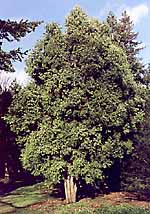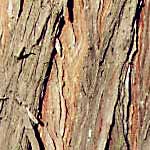
A 7 m tall tree in the Seattle arboretum [C.J. Earle].
Common Names
Chilean cedar (2), ciprès de la Cordillera.Taxonomic notes
Syn: Libocedrus chilensis (D. Don) Endlicher (1); Thuja chilensis D. Don; Thuja andina Poepp. and Endlicher (2).Description
Tree: Dioecious (6) evergreen, with a short trunk and narrow crown (2).Bark: Reddish-brown, peeling in threads (2).
Branches:
Shoots: Dense, flat (2).
Leaves: Scale-like, lateral leaves much longer than facial ones, thick, curving inwards at the pointed apex, facial leaves blunt, with an indistinct gland on the upper surface and whitish bands on the lower surface (2).
Cones: Solitary, with 2 pairs of scales, the lower ones small and reflexed (2).
Cone scales:
Pollen cones:
Seeds: Small, unequally 2-winged, usually 4 to a cone (2).
Wood:
Similar species:
Range
Mountains of S Chile and S Argentina (1). It occupies an exceptionally broad soil moisture gradient and, like many conifers, is exceptionally nitrogen-conservative (5). Lately, a series of papers has closely examined the influence of climate and landscape management variability on the structure and extent of A. chilensis forests. Forest structure has been strongly influenced by changing fire frequency and severity, with much more open stand structures during periods before European occupancy and during the early settlement period, followed by a coalescence of forest patches and increasing stand densities during the period of fire suppression (most of the 20th Century). Individual fire events are strongly influenced by climatic variables such as the ENSO (El Niño - Southern Oscillation) cycles. Both fire and grazing by introduced large herbivores (deer and cattle) are affecting current stand recruitment (8, 9, 10).Big Tree
Oldest
One tree-ring sample, probably based on live tree material, is 850 years long (3).Dendrochronology
Ethnobotany
Observations
Remarks
Austrocedrus chilensis stands are in decline throughout the species' natural distribution. The problem was noted several decades ago but its causes are unknown. Analysis using topographic and climatic information from 32 sites within the Nahuel Huapi National Park shows that A. chilensis forest decline is most severe at sites with relatively high precipitation and low altitudes. Near the eastern limit of its distribution, where precipitation is low, A. chilensis forests show no symptoms of decline. The data suggest that the decline reflects the action of a root pathogen (4), perhaps a relative of the introduced root rot Phytophthora lateralis that is decimating natural populations of Chamaecyparis lawsoniana in southwest Oregon (USA) (7).Citations
(1) Silba 1986.(2) Vidakovic 1991.
(3) International Tree-Ring Data Bank, sample CHIL007, limiting dates 1131-1981.
(4) N.B. Baccala, P.H. Rosso, and M. Havrylenko. 1998. Austrocedrus chilensis mortality in the Nahuel Huapi National Park (Argentina). Forest Ecology and Management 109(1-3): 261-269.
(5) G. Buamscha, M. Gobbi-M, M.J. Mazzarino, and F. Laos. 1998. Indicators of nitrogen conservation in Austrocedrus chilensis forests along a moisture gradient in Argentina. Forest Ecology and Management 112(3): 253-261.
(6) C. Castor, J.G. Cuevas, M.T.K. Arroyo, Z. Rafii, R. Dodd and A. Penaloza. 1996. Austrocedrus chilensis (D. Don) Pic-Ser et Bizz (Cupressaceae) from Chile and Argentina: Monoecious or dioecious? Revista Chilena de Historia Natural 69(1): 89-95.
(7) G.M. Filip and P.H. Rosso. 1999. Cypress mortality (mal del ciprés) in the Patagonian Andes: comparisons with similar forest diseases and declines in North America. European Journal of Forest Pathology 29(2): 89-96.
ABSTRACT: Widespread mortality of Cordilleran cypress (Austrocedrus chilensis) occurs in developed and pristine forests in south-western Argentina and possibly south-eastern Chile. Affected trees may die rapidly but mortality is commonly preceded by several decades of severely restricted radial stem growth. Roots are often affected by one or more types of decay. Cypress mortality, locally termed 'mal del cipres', is similar to a major forest disease in North America: Port-Orford-cedar (Chamaecyparis lawsoniana) root disease in Oregon and California and a major tree decline: Alaska yellow-cedar (Chamaecyparis nootkatensis) decline in south-east Alaska. This paper discusses several hypotheses concerning mal del ciprés and compares current forest decline research in Patagonia with North America.
(8) T. Kitzberger and T.T. Veblen. 1999. Fire-induced changes in northern Patagonian landscapes. Landscape Ecology 14(1): 1-15.
ABSTRACT: In northern Patagonia, Argentina we quantify changes in fire frequency along a gradient from mesic Nothofagus dombeyi forest to xeric woodlands of Austrocedrus chilensis at the steppe ecotone, and we examine patterns of vegetation change coincident with the changes in fire regimes across a range of spatial scales. At a regional scale changes in land cover types are documented by comparing 1:250 000 scale cover type maps from 1913 and 1985. Changes in landscape structure are analyzed by comparing vegetation patterns on 1:24 000 scale aerial photographs taken in 1940 and 1970. Fire frequency peaked in the late nineteenth-century due to widespread burning and clearing of forests by European settlers late in the century. Subsequently, fire frequency declined dramatically about 1910 due to the cessation of intentional fires and has remained low due to increasingly effective fire exclusion. At a regional scale there has been a dramatic increase during the twentieth century in the proportion of forest cover relative to areas mapped as recent burns or shrublands in 1913. Remnant forest patches that survived the widespread late-nineteenth century burning have coalesced to form more continuous forest covers, and formerly continuous areas of shrublands have become dissected by forest. Under reduced fire frequency there has been a shift in dominance from short-lived resprouting species (mostly shrubs) towards longer-lived species and obligate seed-dispersers such as Austrocedrus chilensis and Nothofagus dombeyi. Due to limited seed dispersal of these tree species, the spatial configuration of remnant forest patches plays a key role in subsequent changes in landscape pattern.
(9) M.A. Relva and T.T. Veblen. 1998. Impacts of introduced large herbivores on Austrocedrus chilensis forests in northern Patagonia, Argentina. Forest Ecology and Management 108(1-2): 27-40.
ABSTRACT: Austrocedrus chilensis (D. Don) et Boutleje (Cupressaceae) is an endemic conifer of northern Patagonia, Argentina and south-central Chile, which has been affected by browsing by livestock and introduced deer (especially red deer). In northern Patagonia, we studied the effects of livestock and deer on the densities and heights of Austrocedrus saplings and on the structure and floristic composition of the vegetation in which this species occurs under a variety of different browsing regimes. Twenty-seven stands were sampled within the 'Compact' forest type (i.e., dense and pure) of Austrocedrus in both national reserves and on unprotected properties. Principal components analysis (PCA) indicates that greater abundance of Austrocedrus saplings is associated with lower stand basal areas as expected for this relatively shade-intolerant species. Although browsing does not directly reduce the abundance of saplings, it has an important influence in terms of reducing height growth and producing deformed stems. Multiple correspondence analysis (MCA) indicates that saplings between 0.5 and 1 m in height were more frequently browsed than other height classes; saplings shorter than 0.3 m in height were not greatly influenced by browsing. Saplings of intermediate heights (0.5-1 m) were scarce at sites lacking any current browsing, but this may reflect release of saplings from earlier browsing and subsequent inhibition of continued recruitment into intermediate height classes. High browsing indexes occur beneath canopy gaps, which are also sites of higher sapling densities. In the present study, sites characterized by heavy browsing also have a high cover of spiny shrubs (Berberis spp.) and other unpalatable woody species (e.g., Lomatia hirsuta). Where the preferred browse species, Schinus patagonicus, is abundant, Austrocedrus is less influenced by browsing. However, as browsing reduces the abundance of S. patagonicus, Austrocedrus becomes a preferred species. Austrocedrus stands that are in a phase of fine-scale gap-phase regeneration are the most susceptible to inhibition of tree regeneration by livestock and deer browsing. In such stands, long-term persistence of a forest cover requires protection from large browsing animals.
(10) T.T. Veblen, T. Kitzberger, R. Villalba, and J. Donnegan. 1999. Fire history in northern Patagonia: The roles of humans and climatic variation. Ecological Monographs 69(1): 47-67.
ABSTRACT: The effects of humans and climatic variation on fire history in northern Patagonia, Argentina, were examined by dating fire scars on 458 trees at 21 sites in rain forests of Fitzroya cupressoides and xeric woodlands of Austrocedrus chilensis from 39 degrees to 43 degrees S latitude. Climatic variation associated with fires was analyzed on the basis of 20th-century observational records and tree ring proxy records of climatic variation since approximately AD 1500. In the Austrocedrus woodlands, fire frequency increases after about 1850, coincident with greater use of the area by Native American hunters. Increased burning, particularly in the zone of more mesic forests, is also strongly associated with forest clearing by European settlers from about 1880 to the early 1900s. The marked decline in fire frequency during the 20th century coincides with both the demise of Native American hunters in the 1890s and increasingly effective fire exclusion. Strong synchroneity in the years of widespread fire at sample sites dispersed over a north-south distance of ~400 km indicates a strong climatic influence on fire occurrence at an annual scale. Tree ring reconstructions of regional precipitation and temperature show a steeply declining influence of climatic variability on fire occurrence from annual to multidecadal scales. It is the interannual variability in climate, rather than variations in average climatic conditions over longer periods, that strongly influences fire regimes in northern Patagonia. Although climatic variability overrides human influences on fire regimes at an interannual scale, human activity is an equally important determinant of fire frequency at multidecadal scales.Climatic conditions conducive to widespread fire in both xeric Austrocedrus woodlands and Fitzroya rain forests are typical of the late stages of La Niña (cold phase of the Southern Oscillation) events, as indicated by trends in the Southern Oscillation Index and eastern tropical Pacific sea surface temperatures during the 1-2 years before and after fire event years. Years of extreme fire occurrence are associated both with dry winter-springs of La Niña events and with the warm summers following El Niño events. Years in which the southeast Pacific subtropical anticyclone is intense and located farther south than normal are years of enhanced drought and fire. Similarly, years of widespread fire in northern Patagonia are associated with variations in mean sea level atmospheric pressure at about 50 degrees-60 degrees S latitude in the South American-Antarctic Peninsula sector of the Southern Ocean, as reconstructed from tree rings for AD 1746-1984. Precipitation and, hence, fire regimes in northern Patagonia are significantly influenced by high-latitude blocking events, which drive westerly cyclonic storms northward. Variations at decadal to centennial time scales in major circulation features, such as ENSO activity and the meridionality of regional air flow at high latitudes, as well as changes in the degree of coupling of these features, influence climate and fire regimes of northern Patagonia.
back | Austrocedrus | Cupressaceae | home
This page is from the Gymnosperm Database
URL: http://www.geocities.com/~earlecj/cu/au/index.htm
Edited by Christopher J. Earle
E-mail:earlecj@earthlink.com
Last modified on 24-Oct-1999
